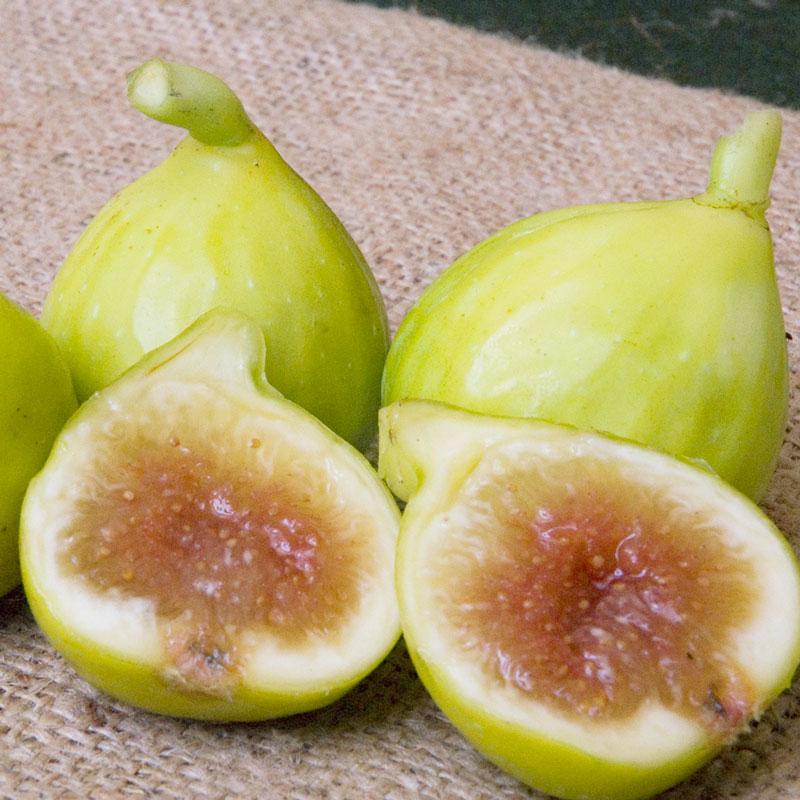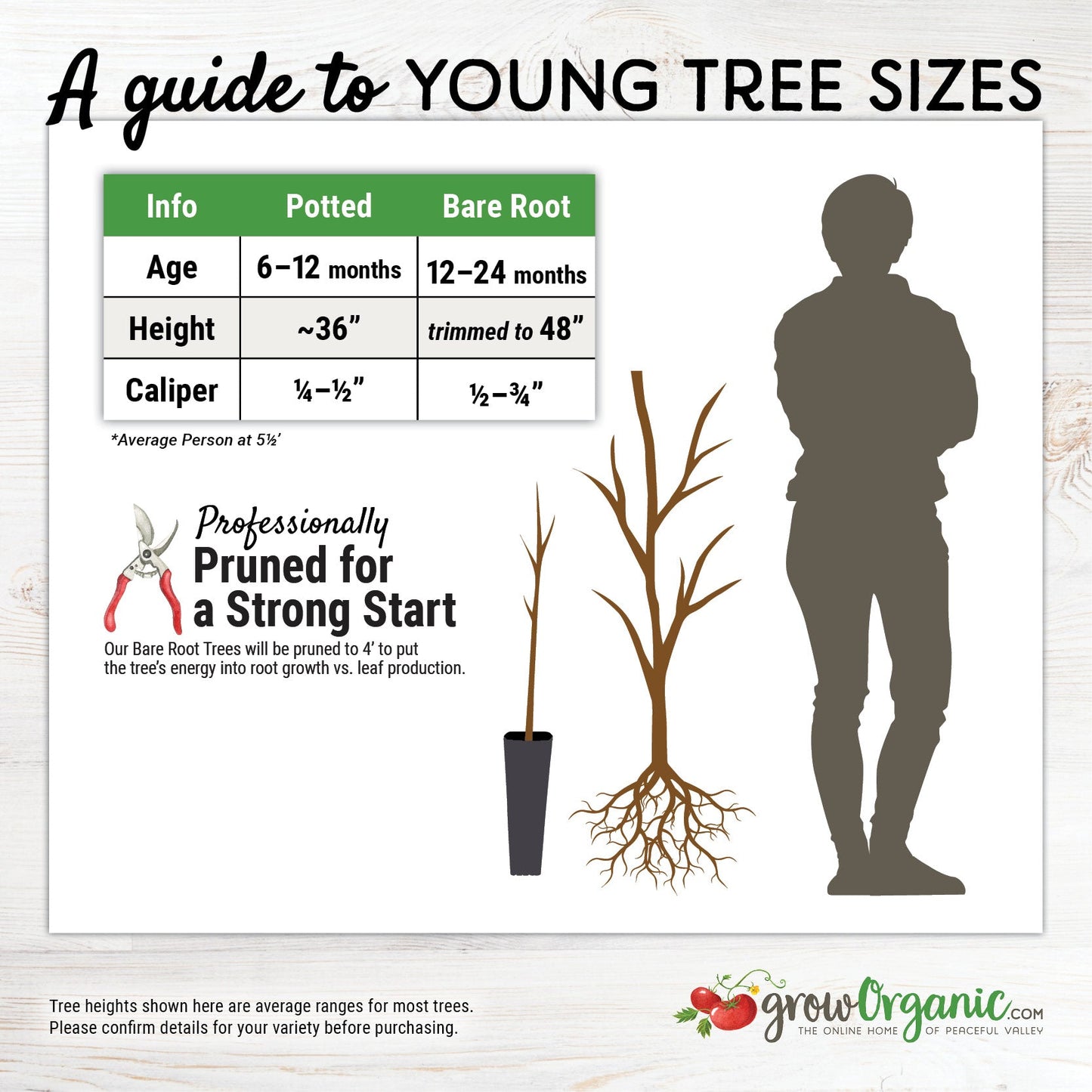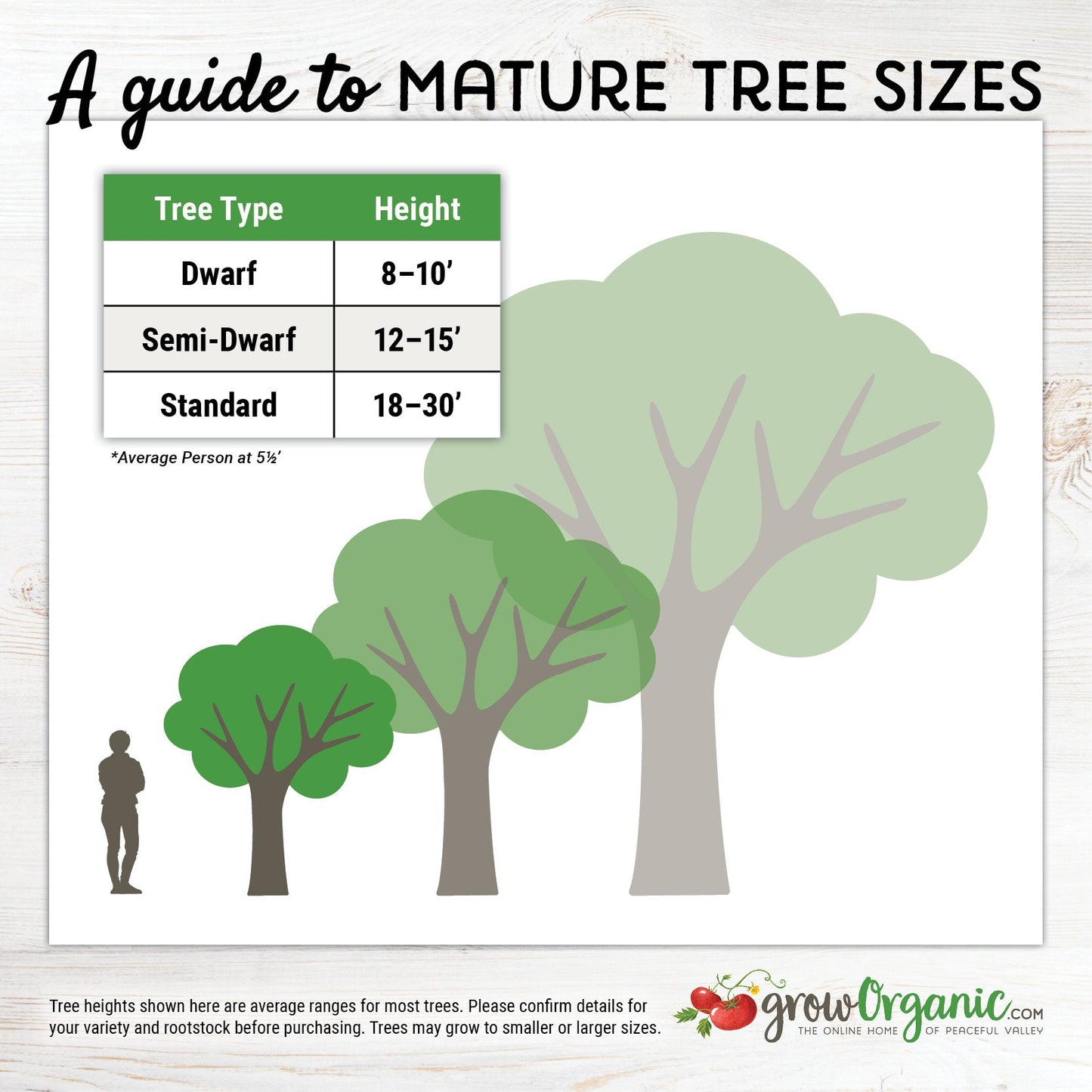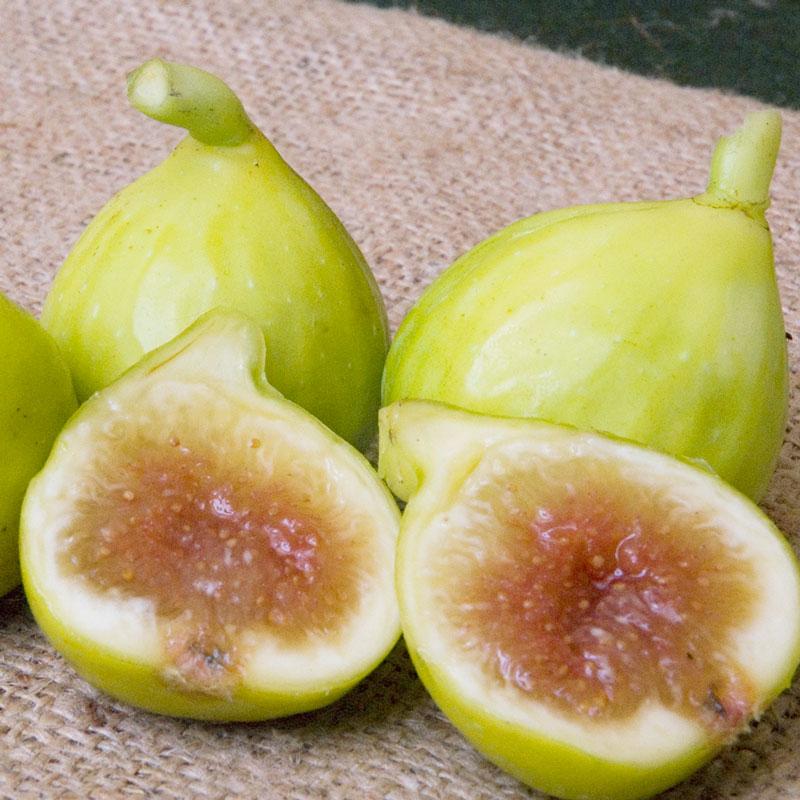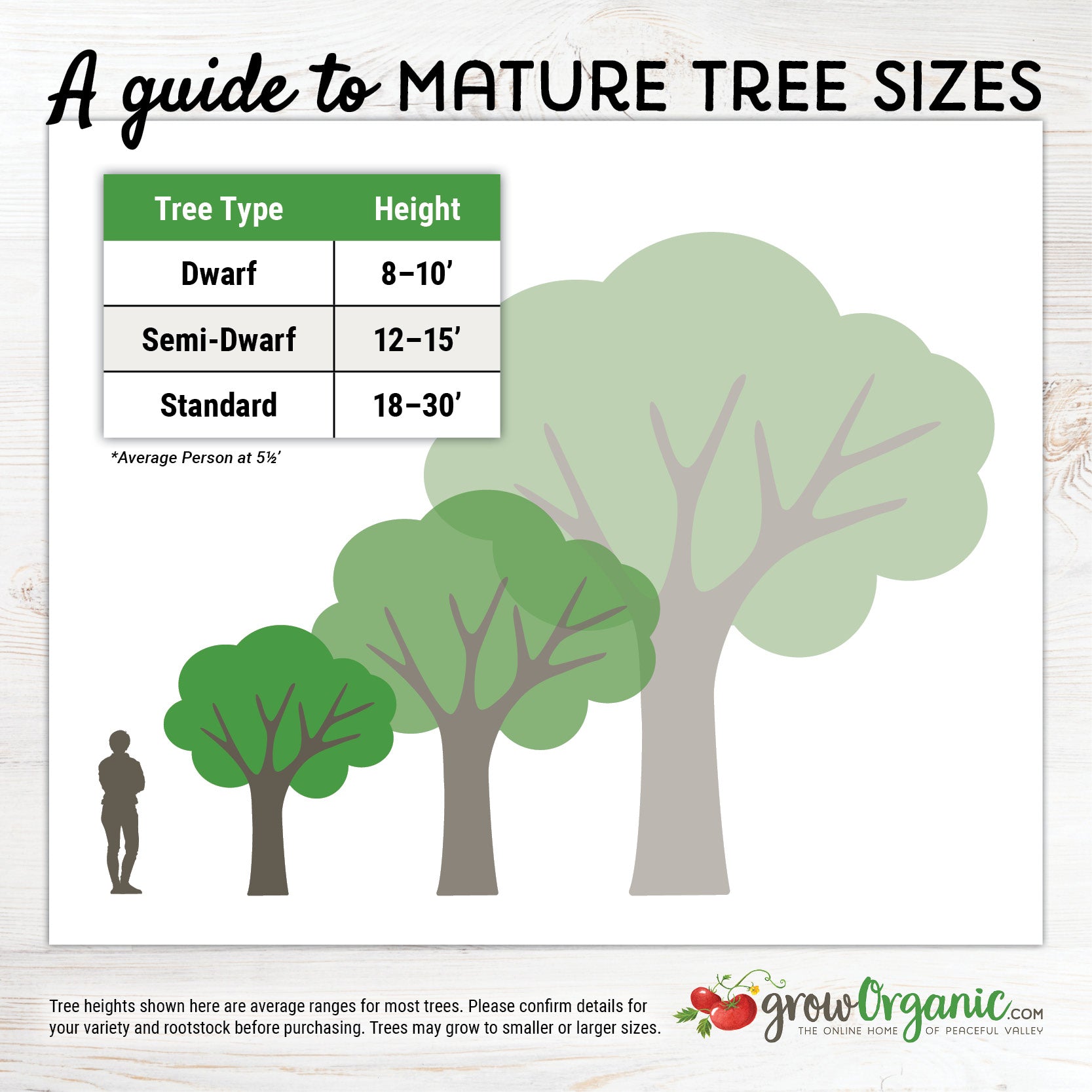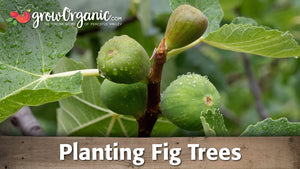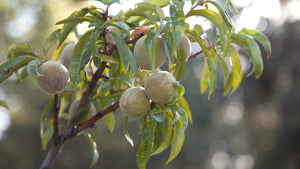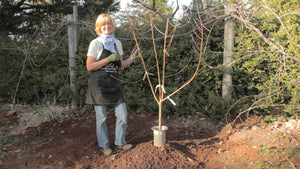Item Number: FT105
Kadota Fig Tree
Kadota Fig Tree
Great Flavor Fig Tree, Many Uses
Standard
- Zones: 7-9
- Chill hours: 100
- Harvest: August 10 - November 5
- Looks: Fruit is large, with light green-yellow "white" skin and amber flesh.
- Personality: Very sweet taste if it has hot weather for ripening.
- Facts of note: Dave Wilson's Taste Test Top Scorer. Long-lived, vigorous tree you can prune to any shape. Delicious fresh or dried. Its great flavor it is the favorite variety for canning.
- Pollination: Self-pollinated.
The Kadota Fig Tree, scientifically known as Ficus carica 'Kadota,' is a popular fruit-bearing tree that has captivated gardeners and fruit enthusiasts alike. Renowned for its sweet and succulent fruits, the Kadota Fig Tree is a delightful addition to any garden or orchard.
Overview of the Kadota Fig Tree:
Scientific Name: Ficus carica 'Kadota'
Common Name: Kadota Fig Tree
Origin: The Kadota Fig Tree is believed to have originated in Egypt and is one of the ancient cultivars of fig trees.
Fruit Type: The tree produces medium-sized, greenish-yellow figs with a sweet, honey-like flavor and a delicate, smooth texture.
Growth Habit: Kadota Fig Trees typically have a spreading and bushy growth habit, making them well-suited for both orchard and container cultivation.
Size: Mature Kadota Fig Trees can reach a height of 8 to 10 feet, with a similar spread.
Unique Characteristics of Kadota Figs:
The fruit of the Kadota Fig Tree is a standout feature that has earned it a special place among fig enthusiasts. Here are some unique characteristics of Kadota figs:
Sweet Flavor: Kadota figs are known for their exceptionally sweet flavor, often described as honey-like or sugary. They have a rich, delightful taste that appeals to a wide range of palates.
Greenish-Yellow Skin: The fruits have a greenish-yellow skin that may have a slight amber blush when fully ripe. This distinctive color makes them easily identifiable.
Soft and Tender Flesh: The flesh of Kadota figs is soft, tender, and almost seedless, making them a favorite for fresh consumption, preserves, or baking.
Prolific Yield: Kadota Fig Trees are known for their abundant fruit production, ensuring a bountiful harvest for the home gardener.
Growing and Caring for Kadota Fig Trees:
Kadota Fig Trees are relatively easy to grow and maintain. Here are some essential care guidelines:
Sunlight: Kadota Fig Trees thrive in full sun, requiring at least 6 to 8 hours of direct sunlight daily.
Soil: They prefer well-draining soil with a slightly alkaline pH. Amending the soil with organic matter can improve its fertility and drainage.
Watering: Provide consistent and deep watering, especially during the growing season. However, avoid waterlogged conditions, as fig trees are susceptible to root rot.
Pruning: Regular pruning helps maintain the tree's shape, improves air circulation, and encourages fruit production. Prune in late winter or early spring before new growth begins.
Fertilization: Fertilize your Kadota Fig Tree in the spring with a balanced, slow-release fertilizer to promote healthy growth and fruiting.
Disease and Pest Control: Keep an eye out for common fig pests like aphids, scale insects, and spider mites. Applying neem oil or insecticidal soap can help control these issues. Additionally, Kadota fig trees are generally less susceptible to diseases compared to other fruit trees.
Health Benefits and Culinary Uses:
Kadota figs offer several health benefits and are versatile in the kitchen:
Nutrient-Rich: Figs are a good source of dietary fiber, vitamins (such as vitamin K and B vitamins), and essential minerals like potassium and magnesium.
Antioxidant Properties: Figs contain antioxidants that help combat oxidative stress and inflammation in the body.
Culinary Uses: Kadota figs are perfect for eating fresh, adding to salads, making preserves, or using as a topping for desserts and yogurt.
Dried Figs: They can also be dried to create a sweet and nutritious snack.
The Kadota Fig Tree, with its delectable sweet fruits, ease of cultivation, and ornamental value, is a fantastic addition to any garden. Whether you're a seasoned gardener or a novice, growing a Kadota Fig Tree can be a rewarding experience. Enjoy the benefits of fresh, homegrown figs while adding an attractive and productive tree to your outdoor space. Embrace the delicious flavors and numerous culinary possibilities that this remarkable tree offers, and watch your garden thrive with the presence of the Kadota Fig Tree.
Visit our Fruit Tree Central for a listing of all our fruit tree videos and articles.
Visit Tree Characteristics for a listing of all our fruit & nut tree growing characteristics.


Check Your Zone Compatibility:
Compatible with your zone.
Growing Zone for
,

Our Guarantee To You
Since 1976, we've served our customers at every stage of growing. Please contact us at any time. We are happy to support and assist you.
Description
Description
Standard
- Zones: 7-9
- Chill hours: 100
- Harvest: August 10 - November 5
- Looks: Fruit is large, with light green-yellow "white" skin and amber flesh.
- Personality: Very sweet taste if it has hot weather for ripening.
- Facts of note: Dave Wilson's Taste Test Top Scorer. Long-lived, vigorous tree you can prune to any shape. Delicious fresh or dried. Its great flavor it is the favorite variety for canning.
- Pollination: Self-pollinated.
The Kadota Fig Tree, scientifically known as Ficus carica 'Kadota,' is a popular fruit-bearing tree that has captivated gardeners and fruit enthusiasts alike. Renowned for its sweet and succulent fruits, the Kadota Fig Tree is a delightful addition to any garden or orchard.
Overview of the Kadota Fig Tree:
Scientific Name: Ficus carica 'Kadota'
Common Name: Kadota Fig Tree
Origin: The Kadota Fig Tree is believed to have originated in Egypt and is one of the ancient cultivars of fig trees.
Fruit Type: The tree produces medium-sized, greenish-yellow figs with a sweet, honey-like flavor and a delicate, smooth texture.
Growth Habit: Kadota Fig Trees typically have a spreading and bushy growth habit, making them well-suited for both orchard and container cultivation.
Size: Mature Kadota Fig Trees can reach a height of 8 to 10 feet, with a similar spread.
Unique Characteristics of Kadota Figs:
The fruit of the Kadota Fig Tree is a standout feature that has earned it a special place among fig enthusiasts. Here are some unique characteristics of Kadota figs:
Sweet Flavor: Kadota figs are known for their exceptionally sweet flavor, often described as honey-like or sugary. They have a rich, delightful taste that appeals to a wide range of palates.
Greenish-Yellow Skin: The fruits have a greenish-yellow skin that may have a slight amber blush when fully ripe. This distinctive color makes them easily identifiable.
Soft and Tender Flesh: The flesh of Kadota figs is soft, tender, and almost seedless, making them a favorite for fresh consumption, preserves, or baking.
Prolific Yield: Kadota Fig Trees are known for their abundant fruit production, ensuring a bountiful harvest for the home gardener.
Growing and Caring for Kadota Fig Trees:
Kadota Fig Trees are relatively easy to grow and maintain. Here are some essential care guidelines:
Sunlight: Kadota Fig Trees thrive in full sun, requiring at least 6 to 8 hours of direct sunlight daily.
Soil: They prefer well-draining soil with a slightly alkaline pH. Amending the soil with organic matter can improve its fertility and drainage.
Watering: Provide consistent and deep watering, especially during the growing season. However, avoid waterlogged conditions, as fig trees are susceptible to root rot.
Pruning: Regular pruning helps maintain the tree's shape, improves air circulation, and encourages fruit production. Prune in late winter or early spring before new growth begins.
Fertilization: Fertilize your Kadota Fig Tree in the spring with a balanced, slow-release fertilizer to promote healthy growth and fruiting.
Disease and Pest Control: Keep an eye out for common fig pests like aphids, scale insects, and spider mites. Applying neem oil or insecticidal soap can help control these issues. Additionally, Kadota fig trees are generally less susceptible to diseases compared to other fruit trees.
Health Benefits and Culinary Uses:
Kadota figs offer several health benefits and are versatile in the kitchen:
Nutrient-Rich: Figs are a good source of dietary fiber, vitamins (such as vitamin K and B vitamins), and essential minerals like potassium and magnesium.
Antioxidant Properties: Figs contain antioxidants that help combat oxidative stress and inflammation in the body.
Culinary Uses: Kadota figs are perfect for eating fresh, adding to salads, making preserves, or using as a topping for desserts and yogurt.
Dried Figs: They can also be dried to create a sweet and nutritious snack.
The Kadota Fig Tree, with its delectable sweet fruits, ease of cultivation, and ornamental value, is a fantastic addition to any garden. Whether you're a seasoned gardener or a novice, growing a Kadota Fig Tree can be a rewarding experience. Enjoy the benefits of fresh, homegrown figs while adding an attractive and productive tree to your outdoor space. Embrace the delicious flavors and numerous culinary possibilities that this remarkable tree offers, and watch your garden thrive with the presence of the Kadota Fig Tree.
Visit our Fruit Tree Central for a listing of all our fruit tree videos and articles.
Visit Tree Characteristics for a listing of all our fruit & nut tree growing characteristics.
Sub-tropical, drought tolerant fruit tree. Fig trees are possibly the very first domesticated fruit. There is evidence of fig cultivation as early as 4,000 B.C. The sweetest figs develop when the daytime temperature regularly exceeds 95°F. Figs thrive in most soil types, as long as it's well-drained, and they will fruit in a variety of climates. Fig trees need hardly any cold period to produce fruit. Mature fig trees are hardy to 15°F. Will re-grow from roots if winter-killed.
Mature standard trees grow to 25' tall and 40' wide if not pruned, semi-dwarf trees can get 12-15' tall. Figs need warm soil for their roots to start growing. Figs do not like to be planted as bare-roots and are difficult to establish, so we sell these No. 1 size trees (about 1/4"-3/8" caliper) in pots (4" x 4" x 9") to enhance their survival rate. Trees are 1 year old and should begin to fruit in same year you plant them.
See our article How to Plant a Fig Tree for more details.
Shipping Information
Shipping Information
Cannot ship to the following states: AK, HI, PR, VI, GU
Cannot ship via USPS.
Cannot ship via SmartPost.
Shipping Weight: 5.5 lb
Dimensions: 35.9"L x 3.9"W x 3.9"H
Features
Features
- Flavor Pick
- Potted
- Self-fruitful
- Suited to Warmer Climates
Characteristics
Characteristics
Planting & Care
Planting & Care
Useful Information
Useful Information
Guarantee
Guarantee
We guarantee the perishable items we sell to be in good, viable condition when we sell them. Perishable items include, but are not limited to, garlic bulbs, flower bulbs, seed potatoes, onion sets & transplants, potted or bare root trees, vegetable crowns, etc. If your perishable item arrives in substandard condition, take photographs and please contact us within 3 days of the purchase date (or delivery date) and we will provide you with a refund of the purchase price (excluding shipping costs), or a replacement. Accordingly, we urge you to open any boxes marked as ""Perishable"" immediately upon receiving them and inspect the shipment thoroughly (do not crack open heads of garlic, we do not accept claims on cracked garlic). Because some perishable items can deteriorate very quickly, we cannot accept any claims beyond the 3-day time frame as it becomes too difficult to determine if these items were delivered in substandard condition, or if they turned into such substandard condition because of having been improperly cared for or stored once delivered.
Share
